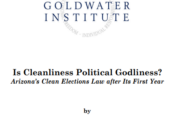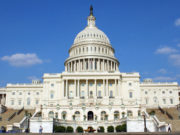Recent years have witnessed a shrinking of the legal rationale for restricting the ability of independent groups to spend funds urging voters to support or oppose candidates. In response, those seeking to “get money out of politics” have turned to new avenues to counter what they perceive as the outsized influence of wealthy voices in elections and policymaking.
One of the more popular suggestions is actually an old idea: tax-financed campaign programs. For the unfamiliar, these programs offer participating candidates taxpayer dollars to fund their campaigns, in the hopes that doing so will reduce their reliance on wealthy donors and lead to a more diverse and representative pool of candidates winning public office.
Or so proponents used to argue. If the report issued by Public Campaign, a prominent advocate of tax-financing schemes, on the performance of tax-financed campaign programs in the 2014 elections is any indication, the case for so-called “clean elections” is rapidly changing. You might even say it’s deteriorating.
That’s not really surprising, because the old arguments for tax-financed campaigns have long fallen apart under scrutiny. Years of experience in states that operate such systems – Arizona and Maine since 2000 and Connecticut since 2008 – have shown that these government programs do not reduce lobbying, do not result in greater occupational diversity within legislatures, do not increase the percentage of women in legislatures, do not result in savings to taxpayers through decreased legislative spending, do not change the likelihood of politicians siding with organized interests, and do not increase voter turnout.
Unsurprisingly, the new case for tax-financing programs is far more tame. Public Campaign’s report does not discuss bills passed in legislatures elected under a system of so-called “clean” elections that others do not. It does not compare states with comprehensive tax-financing programs to states without them. It simply analyzes candidate participation in existing programs. Here are the report’s “key findings:”
- Nearly 300 officials elected this fall in Connecticut, Maine, and Arizona ran with public grants after raising local, small donations.
- A full 84 percent of the incoming Connecticut legislature was elected under the state’s Citizens’ Election public financing program. All six winning statewide candidates used the program.
- A majority of winning legislative candidates participated in Maine’s Clean Elections program.
- At the federal level, outside spending mattered tremendously in a small set of key races, but it is traditional candidate fundraising that most candidates still rely on.
[…]
- Small donors, those donating $200 or less, gave a combined $1 billion to federal candidates, party committees, and political action committees (PACs) this cycle. While federal candidates can do more to reach small donors, Americans have shown their willingness, in large numbers, to engage politically through small contributions.
These statistics say absolutely nothing about whether tax-financing programs are any good. In fact, they don’t seem to inform the debate over tax-financed campaigns in any meaningful way.
A quick recap of that debate: For years, critics of tax-financing programs have decried their infringement on First Amendment rights while arguing that given all the competing demands on the public’s money – from education to health care to transportation to public safety and beyond – funding the campaigns of politicians just doesn’t match up. For years, supporters have responded that this line of critique is short-sighted, because without a “clean” legislature, public resources would never be allocated wisely.
This debate kept the focus where it should be: is the public benefitting?
Now, as the evidence mounts that tax-financed campaigns are not a panacea for ending corruption or improving government, tax-financing advocates are seemingly trying to change the game. Public Campaign’s enthusiasm for citing participation rates in tax-financing programs shifts the conversation to an entirely different question: are politicians benefiting?
You can see this mindset throughout the report. After bemoaning current trends in campaign finance, the report states, “[t]here’s some good news. State-level, broad “clean elections” models are still drawing in hundreds of candidates, with Connecticut leading the way.” Good news for whom? Without evidence that tax-financed candidates behave differently in office, why should citizens be happier that they are funding their campaigns with tax dollars?
Later, the report touts that “politicians from both major parties maintained confidence in [Connecticut’s] citizen-owned elections.” Again, who cares? There’s no reason to think the best campaign system for voters will be the same as the one that makes politicians happiest. If anything, we should expect the opposite.
The great irony here is that after years of trying to refute the criticism that tax-financed campaign programs function as a thinly-veiled “welfare program for politicians,” tax-financing advocates are now judging success on precisely those terms: the more public money put into the hands of politicians, the better the program.
I can see why that would appeal to politicians, but I’m not sure what’s in it for the public.














